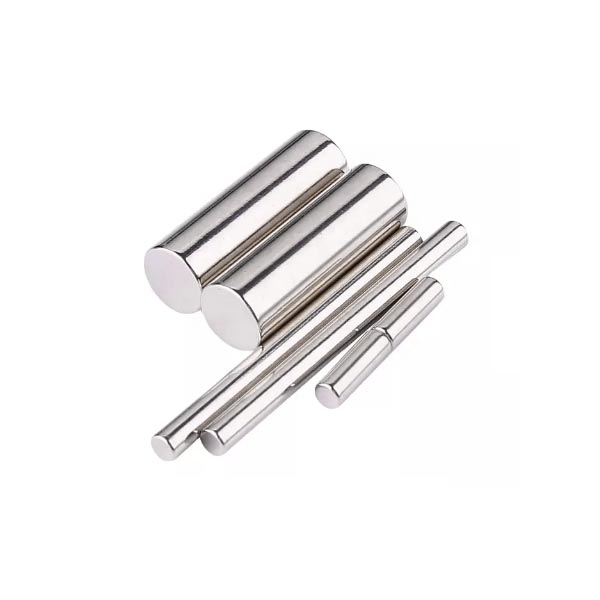We will explain how NdFeB magnets are made with a simple description. The neodymium magnet is a permanent magnet made from an alloy of neodymium, iron, and boron to form the Nd2Fe14B tetragonal crystalline structure. Sintered neodymium magnets are made by vacuum heating rare earth metal particles as raw materials in a furnace. After getting the raw materials, we will carry out 9 steps to make NdFeB magnets and finally produce finished products.
Prepare materials for reacting, melting, milling, pressing, sintering, machining, plating, magnetization and inspection.
Prepare materials for reacting
The chemical compound form of neodymium magnet is Nd2Fe14B.
Magnets are usually Nd and B rich, and finished magnets usually contain nonmagnetic sites of Nd and B in the grains, which contain highly magnetic Nd2Fe14B. grains. Several other rare earth elements can be added to partially replace neodymium: dysprosium, terbium, gadolinium, holmium, lanthanum, and cerium. Copper, cobalt, aluminum, gallium and niobium can be added to improve other properties of the magnet. It is common to use both Co and Dy together. All elements to manufacture magnets of the selected grade are placed in a vacuum induction furnace, heated and melted to form the alloy material.
Melting
The raw materials need to be melted in a vacuum induction furnace to form the Nd2Fe14B alloy. The product is heated by creating a vortex, all under vacuum to prevent contamination from entering the reaction. The final product of this step is a thin-ribbon cast sheet (SC sheet) composed of uniform Nd2Fe14B crystals. The melting process needs to be done in a very short time to avoid excessive oxidation of the rare earth metals.
Milling
The 2-step milling process is used in manufacturing practice. The first step, called hydrogen detonation, involves the reaction between hydrogen and neodymium with the alloy, breaking the SC flakes into smaller particles. The second step, called jet milling, turns the Nd2Fe14B particles into smaller particles, ranging in diameter from 2-5μm. Jet milling reduces the resulting material to a powder of very small particle size. The average particle size is around 3 microns.
Pressing
NdFeB powder is pressed into a solid in the desired shape in a strong magnetic field. A compressed solid will acquire and maintain a preferred magnetization orientation. In a technique called die-upsetting, the powder is pressed into a solid in a die at about 725°C. The solid is then placed into a second mold, where it is compressed into a wider shape, about half its original height. This makes the preferred magnetization direction parallel to the extrusion direction. For certain shapes, there are methods that include clamps that generate a magnetic field during pressing to align the particles.
Sintering
Pressed NdFeB solids need to be sintered to form NdFeB blocks. The material is compressed at high temperatures (up to 1080°C) below the melting point of the material until its particles adhere to each other. The sintering process consists of 3 steps: dehydrogenation, sintering and tempering.
Machining
Sintered magnets are cut into desired shapes and size using a grinding process. Less commonly, complex shapes called irregular shapes are produced by electrical discharge machining (EDM). Due to the high material cost, material loss due to machining is kept to a minimum. Huizhou Fullzen Technology is very good at manufacturing irregular magnets.
Plating/Coating
Uncoated NdFeB is extremely corroded and loses its magnetism quickly when wet. So, all commercially available neodymium magnets require coating. Individual magnets are plated in three layers: nickel, copper and nickel. For more coating types, please click “Contact Us”.
Magnetization
The magnet is placed in a fixture that exposes the magnet to a very strong magnetic field for a short period of time. It's basically a large coil wrapped around a magnet. Magnetized devices use capacitor banks and very high voltages to get such a strong current in a short amount of time.
Inspection
Check the quality of the resulting magnets for various characteristics. Digital measuring projector verifies dimensions. Coating thickness measurement systems using X-ray fluorescence technology verify the thickness of coatings. Regular testing in salt spray and pressure cooker tests also verifies the performance of the coating. The hysteresis map measures the BH curve of the magnets, confirming that they are fully magnetized, as expected for the magnet class.
Finally we got the ideal magnet product.
Fullzen Magnetics has more than 10 years of experience in the design and manufacture of custom neodymium magnets. Send us a request for quote or contact us today to discuss your project's specialty requirements, and our experienced team of engineers will help you determine the most cost effective way of providing you with what you need.Send us your specifications detailing your custom magnet application.
If You Are in Business, You May Like
Recommend Reading
Your Custom Custom Neodymium Magnets Project
Fullzen Magnetics has more than 10 years of experience in the design and manufacture of custom rare earth magnets. Send us a request for quote or contact us today to discuss your project's specialty requirements, and our experienced team of engineers will help you determine the most cost effective way of providing you with what you need.Send us your specifications detailing your custom magnet application.
Post time: Dec-21-2022



